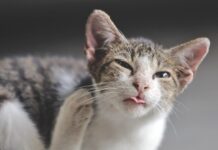Its always been a priority to feed your cat the most nutritious diet available, even if that means paying more for premium cat food. But even the best of foods can contain an ingredient to which she has developed an allergy. If thats the case, youre likely to witness a change in your cats behavior and health. Most noticeably, shes likely to be bothered by intermittent or constant itching. According to Francis Kallfelz, DVM, PhD, board-certified by the American College of Veterinary Nutrition and the emeritus James Law professor of nutrition at Cornell Universitys College of Veterinary Medicine, food allergies are found more commonly in dogs than they are in cats – but they are by no means rare in the general feline population. Approximately once a week, a cat is diagnosed with such an allergy at the Cornell University Hospital for Animals. In fact, studies have shown that food allergies are the third most common type of feline allergy, outranked only by allergies to flea bites and inhaled substances. Itching, scratching and other skin problems are not the only signs of a food allergy. According to Dr. Kallfelz, who is board-certified by the American College of Veterinary Nutrition, an estimated 10 percent to 15 percent of cats with food-induced cutaneous problems also exhibit gastrointestinal signs, such as vomiting, diarrhea and frequent bowel movements. “The skin problems are bad,” he notes. “They can make a cat very uncomfortable, excoriate the skin and make the animal unsightly. But the intestinal problems can be more dangerous if they are allowed to persist.” Potential Consequences. The itching that most commonly signals the presence of an allergy is caused by the eruption of small, fluid-filled lumps on the skin, which form in response to the presence of an allergen, a substance to which an animals system is abnormally sensitive. And in some cases, the animal may suddenly stop eating its food, even if it is the same food that it has been eating for years. But the most commonly seen signs are related to the skin – usually around the ears, eyes and neck – which will be inflamed and covered with little sores. As aggravating as they are, the itchy welts on an allergic cats skin do not pose a serious health hazard. But the incessant scratching that they prompt may cause secondary skin wounds and a resulting vulnerability to severe bacterial infection. In addition, the gastrointestinal problems stemming from a food allergy may have far-reaching systemic implications, including an animals avoidance of its food that can result in health-compromising weight loss. “If youre unable to identify the specific allergen in a cats food and remove it from the diet,” says Dr. Kallfelz, “the consequences can be terrible. The animal wont eat enough to maintain itself, and it may just waste away.” The most visible signs of a food allergy – the persistent scratching, the emergence of skin lesions, loss of hair and a general deterioration of the coat – do not develop overnight. Instead, they tend to become evident and intensify over extended periods of time – months or even years – as the animals immune system gradually mounts a defense against certain protein and carbohydrate molecules that are present in most standard cat foods. “It can take a long time for a cat to develop a food allergy,” Dr. Kallfelz notes, “but once it has developed, it will manifest itself relatively quickly – within a matter of a few hours after the animal has eaten.” Fighting the Invader. To combat these allergens, which are perceived as dangerous invaders, the immune system generates antibodies – cells that are dispatched to destroy the offending substances. In time, the antibodies precipitate the leakage of fluid from the blood into the tissue beneath the skin. The fluid eventually collects to form the aggravating skin eruptions and inflammation. When the signs appear, a cat should receive prompt veterinary care. And if a food allergy is indeed diagnosed, the specific allergen should be identified and removed from the animals diet, since the condition could conceivably be life-threatening as the result of infection and ongoing nutritional malabsorption. The first step in treating a cat with a suspected food allergy is to make the animal comfortable by treating any apparent secondary infections with antibiotics and perhaps by administering steroid medications to curb the itching. Then the veterinarian will attempt to rule out other frequent causes of the skin eruptions and other signs, such as a hypersensitive reaction to a medication or to flea bites. The veterinarian will also try to rule out a possible metabolic cause, such as gastric intolerance of a specific substance – lactose, for example, or a food contaminant. If a food allergy is identified as the probable cause of the clinical signs, the next challenge is to identify what precisely in the cats diet is responsible for the problem. This process will most effectively be carried out at home by the owners introduction of what is termed a “novel diet.” The principle used in devising a novel diet is based on the fact that most feline food allergies are traceable to the protein or carbohydrate content of an affected animals normal fare. These substances are present in the form of large molecules that can bind readily with an immune system cell to produce an allergic reaction. The most commonly used protein sources in cat food include beef, pork, lamb, chicken, turkey and eggs. Since protein is a fundamental component of living cells and is necessary for the proper functioning of an organism, the novel diet must contain protein – but it must be derived from a source to which an affected cat has not been previously exposed. (Many readily available novel diets have been formulated using such unusual protein sources as rabbit, venison, fish and even kangaroo meat.) The same goes for carbohydrates, so the vegetables that are frequently used in cat foods – wheat, barley and corn, for instance – should also be excluded from the novel diet and replaced by, for example, tofu. To perform a conclusive search for the offending allergen, a cat must consume nothing but the novel diet and water for a period of at least eight to 10 weeks. No treats of any kind are allowable during this period. Most veterinarians will be able to recommend a specific diet that is nutritionally sound and contains none of the conventionally used protein or carbohydrate sources.



